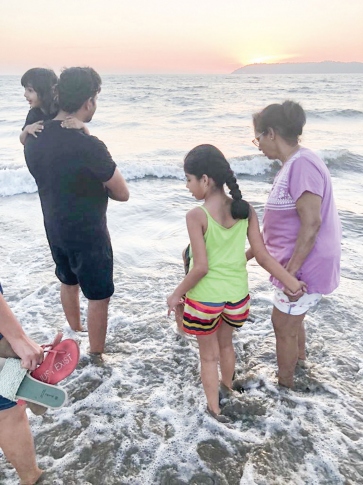
It is that time of the year, where the summer heat becomes a suffocating, relentless oppressor. The alluring, idyllic shores of coastal paradises draws Goans. With sandy stretches that extend as far as the eye can see, cool waters invites one to dive in, and a harmony of crashing waves that serenade the senses, beach destinations become the epitome of everyone’s summer travels. It’s also a summer tradition, an annual ritual of sorts, for the old to head to the sea right before the monsoons, during the period of late April-early June, for salt water baths, as it is believed by some, to be good for health.
A Japanese study has found that seawater can be an effective treatment for dermatitis, a common skin condition. This finding aligns with the practice of Thalassotherapy, where seawater is used for its therapeutic properties.
In Goa, the locals embrace this tradition, firmly believing in the healing power of salt water baths. While the scientific evidence may not be conclusive, anecdotal experiences suggest that the tradition is true. In Goa, the locals call it- the ‘Paim Buddounk’ tradition. The term originates from the Greek word ‘thalassa’, which means ocean. In Ancient Greece, around 2500 years ago, sea water was used to heal and treat eczema, arthritis, asthma, and back pain. The practice also yields mental health advantages, such as enhanced mood, a calmer mental state resulting in reduced anxiety, and alleviation of depression symptoms.
Every year, most Goans, especially the elderly, make it a point to visit beaches and shores to bathe or dip their legs and feet in sea, with the belief that salty water has healing properties. Therefore, they would spend more than a day or two on the shore, eat, drink and relax with their families. Joana Fernandes, an octogenarian, who follows the ‘Paim Buddounk’ tradition, agrees to the fact that she experiences positive effects after dipping her feet in the ocean. She notes that the salty water helps alleviate various ailments such as walking troubles, feet swelling, and pains. The rejuvenating effect of the ocean water also brings about improved sleep and a feeling of lightness, leading to a perceived boost in overall health. She says, “After dipping my feet in the ocean, I feel incredibly good. The salty ocean water, in the month of March, takes away my troubles of the feet. The night after the trip to the beach, the feeling of heaviness reduces. I definitely feel a lot healthier after these trips. The water in the months of March, April, and May are incredibly salty. With the onset of the rainy season, from June onwards, I refrain from visiting the beach.”
People not only enjoy the simple act of dipping their feet in the ocean, but they also indulge in the rejuvenating experience of bathing in its salty waters. This immersive treatment helps them alleviate the pressures and worries of everyday life. “Personally, I have not yet adopted the practice of bathing in the ocean, as I find solace by simply immersing my feet in the gentle waves. However, I make it a ritual to visit the beaches at least two or three times every year, particularly during the months of March. While there are numerous beaches to choose from, I find myself gravitating towards Candolim and Calangute more frequently. Whether it’s a visit to my sister in Candolim, attending the Novenas on Tuesdays, or going on delightful picnics with my family and friends in Baga, I always conclude these excursions with a walk along the sandy shoreline and a dip in the ocean,” adds Joana.
In the earlier days, parents often took their children along with the elders in the family picnicking together on the sea shore. The span of the trip lasted half a day to three or even four days with families packing food for the trip in large utensils and packages. Since transportation was also difficult, families preferred to make the most of the journey for this annual visit to the beach. Even children as young as five or six years old, accompanied by their mothers or grandmothers would bathe in the ocean for this purpose. As their parents followed the tradition, they too continue it with their parents as they grow older.
She says, “Together with my aunts, cousins, and sisters, I would walk to the Calangute beach from my home nearby, to Candolim, Baga and even Sinquerim.”
Melisa D’Cruz, a resident of Aldona, shares a cherished family tradition that has been passed down through generations. Recalling fond memories, she reveals that her grandmother, mother, and now herself, have all practiced this tradition. It is a unique mentality deeply ingrained in the Goan culture, where they firmly believe in the therapeutic benefits it provides for various ailments such as aches, joint pains, arthritis, and even its positive influence on blood pressure and blood sugar levels.
Melisa says, “I remember how she would not only visit the beach but also bring some sea salt home for further use. She would immerse half of her body into the soothing sand, embracing the natural healing properties it was believed to possess. These trips to the beach were not mere day visits but rather a three-day affair, where the entire family would gather, bringing along delicious food and making the most of the time together.”
The continuation of this unique family tradition brings joy and fulfillment to Melisa’s life as she passes it on to her own family.
This enjoyable and meaningful tradition not only promotes physical well-being but also serves as a symbol of the rich Goan culture, passed down through generations as a testament to the enduring power of family and the belief in the natural remedies bestowed by the elements.
It is believed that dipping one’s feet in ocean water helps to soften cracks, eliminate dead skin, and rejuvenate the skin. It also acts as a natural exfoliant and can rinse the body of toxins. Although it may cause a stinging sensation, it is believed to aid in faster healing of cuts. Some Goans hold the belief that if they skip this tradition, they will experience problems throughout the year. Following the tradition gives them a sense of healthiness and provides healing for leg ailments and aches, leaving them feeling incredibly light.
Joana strongly believes in the annual ritual of dipping her feet in the ocean. While there are people who disagree with the idea that the ocean’s salty water possesses healing properties, many have faithfully followed this tradition for decades. Even tourists participate in the practice of ‘Paim Buddounk’ during their summer visits to Goa.
According to many sources, in the olden days, it was often said that this tradition not only eases physical pains but also helped release stress and anxiety, promoting healing for the body, mind, and soul. A research conducted in 2019 that was published in Health and Place, by the University of Exeter, revealed that living in coastal areas could support better mental health and that the well-being benefits should be maximised, while not damaging our fragile ecosystem.
